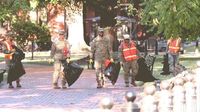On a crisp Tuesday morning in late August 2025, the sight of uniformed National Guard members picking up trash and tending to the grounds near the White House, Lafayette Park, the National Mall, and the Tidal Basin stopped many Washingtonians in their tracks. The spectacle wasn’t part of a drill or a disaster response—it was the visible face of a sweeping federal initiative dubbed the "D.C. Takeover," a program that has ignited both praise and controversy in the nation’s capital.
According to FOX 5 DC, about 110 National Guard soldiers were assigned to cleanup duty this week, hauling away litter and spreading mulch around D.C.’s most iconic landmarks. Their presence is part of a "beautification and restoration mission" coordinated by the Joint Task Force-DC in partnership with the National Park Service. The operation, which is expected to include more than 40 separate tasks across the District, forms a key piece of President Donald Trump’s federal response to rising crime and public disorder in the capital.
While some Guard members patrol with police as part of the broader crime emergency plan, many others have been redirected to community projects—like picking up trash, landscaping, and restoring public spaces. The optics are striking: men and women in fatigues, armed not with weapons, but with gloves and garbage bags, working to "make D.C. beautiful again." As one Southeast D.C. native and Guard member put it in a video posted by the D.C. National Guard, "It feels good to be out here cleaning streets, making D.C. beautiful again. I feel like D.C. really needed this, and I feel like it’s only going to get better and better from here."
The initiative, sometimes referred to as the "Safe and Beautiful Task Force," has drawn attention for its unusual approach to federal intervention. The Joint Task Force-DC office explained in a Monday email update: "Service members assigned to JTF-DC will begin a beautification and restoration mission with National Park Service (NPS) as part of an overarching plan that includes an estimated 40 or more tasks being coordinated across the District." The Guard’s social media posts have echoed this message, emphasizing coordination with federal and local partners and highlighting community restoration projects with hashtags like #SafeAndBeautiful.
President Trump has repeatedly championed the idea of restoring the capital’s public spaces. Promising to "make [Washington] safe; make it smart; make it beautiful," he has positioned the federal deployment as a model for urban renewal. "Restore the city back to the gleaming capital that everybody wants it to be," he vowed, according to Fox News Digital. The beautification push, however, is only one facet of a much larger federal presence. As of Monday, August 25, the Joint Task Force counted 2,234 members deployed in D.C., including 929 from the D.C. National Guard and 1,305 from the National Guards of Louisiana, Mississippi, Ohio, South Carolina, Tennessee, and West Virginia.
The city’s tourism officials, meanwhile, are working hard to shape a different narrative. Destination DC, the city’s official marketing arm, has launched a "We the People DC" advertising campaign that profiles 20 locals who "live, work and thrive" in the city. The campaign is an effort to counter what they see as negative rhetoric and highlight D.C.’s vibrancy, despite the heavy federal presence. In 2024, D.C. welcomed a record 27.2 million visitors, who spent $11.4 billion, generated $2.3 billion in tax revenue, and supported 111,500 jobs, according to Destination DC. While international visitation is projected to decline by 5.1% in 2025—a drop that is less severe than the national average—tourism leaders are pinning their hopes on America’s 250th anniversary in 2026. That milestone year is expected to bring millions more visitors, drawn by new and renovated attractions including the National Archives, an immersive museum under the Lincoln Memorial, an upgraded Jefferson Memorial, the reopening of the National Air and Space Museum’s final galleries, and a new 14-gate concourse at Dulles Airport.
Yet not everyone is convinced that the National Guard’s beautification mission is the best use of federal resources. Jessie Rabinowitz of the National Homeless Law Center voiced sharp criticism on social media, writing, "I just learned that the national guard was seen picking up trash on White House grounds. Why are we spending $1 million a day for them to pick up trash? For one week of DC guard deployment, we could solve homelessness for 150 people for a year." This sentiment has resonated with some local advocates, who question whether the highly visible cleanup efforts are more about optics than substantive change.
The debate extends beyond just cost. Some residents appreciate the improvements to public spaces, especially after years of complaints about litter, neglected landscaping, and declining maintenance. The image of Guard members scooping, spreading, and smoothing mulch around the Tidal Basin’s famous cherry trees—a scene described by The Washington Post—has been met with both gratitude and skepticism. Supporters argue that the federal government’s involvement is finally addressing long-standing problems, while critics worry that the effort is superficial and potentially diverts attention from deeper issues, such as affordable housing, public safety, and social services.
Adding to the complexity, the federal mission’s scope remains somewhat opaque. Officials have acknowledged that more than 40 tasks are on the docket, but they have not provided a comprehensive list of projects or details about how often the Guard will be asked to perform these duties. The National Guard’s own communications have focused on the positive impact of their work, with members expressing pride in contributing to the city’s renewal. "We are committed to keeping D.C. safe and beautiful," one official told FOX 5 DC.
Meanwhile, the broader political battle over Washington’s image continues to play out. The White House did not immediately respond to requests for comment from the press, leaving city officials and community leaders to shape the narrative in their own ways. The "We the People DC" campaign, for instance, seeks to showcase the capital as a place where people "live, work and thrive," hoping to draw attention away from the spectacle of federal troops hauling trash bags and toward the city’s enduring appeal as a destination for business, tourism, and culture.
As Washington prepares for the influx of visitors expected for the nation’s 250th birthday in 2026, the question remains: Will the federal government’s beautification blitz create lasting change, or will it fade as a short-lived show of force? For now, the city’s streets are a little cleaner, the cherry trees a little neater, and the debate over D.C.’s future as lively as ever.

